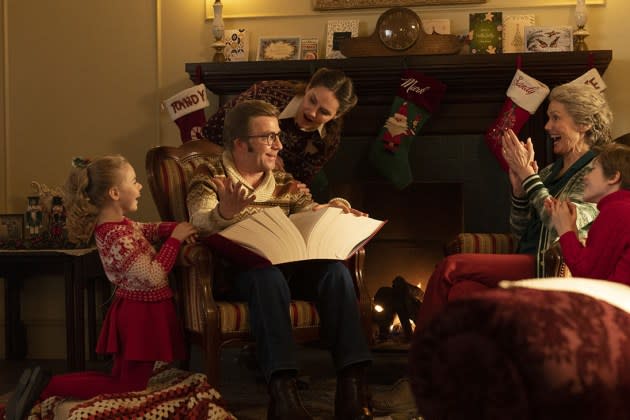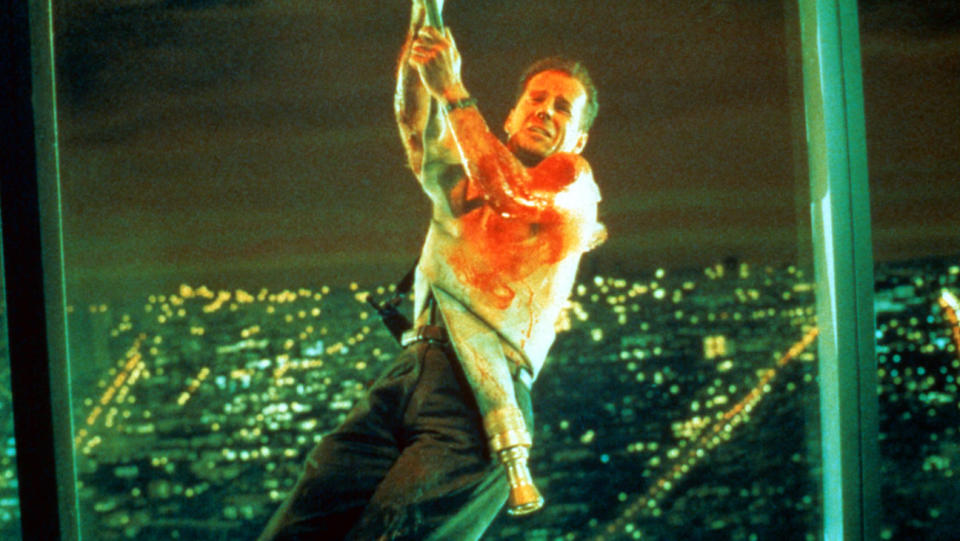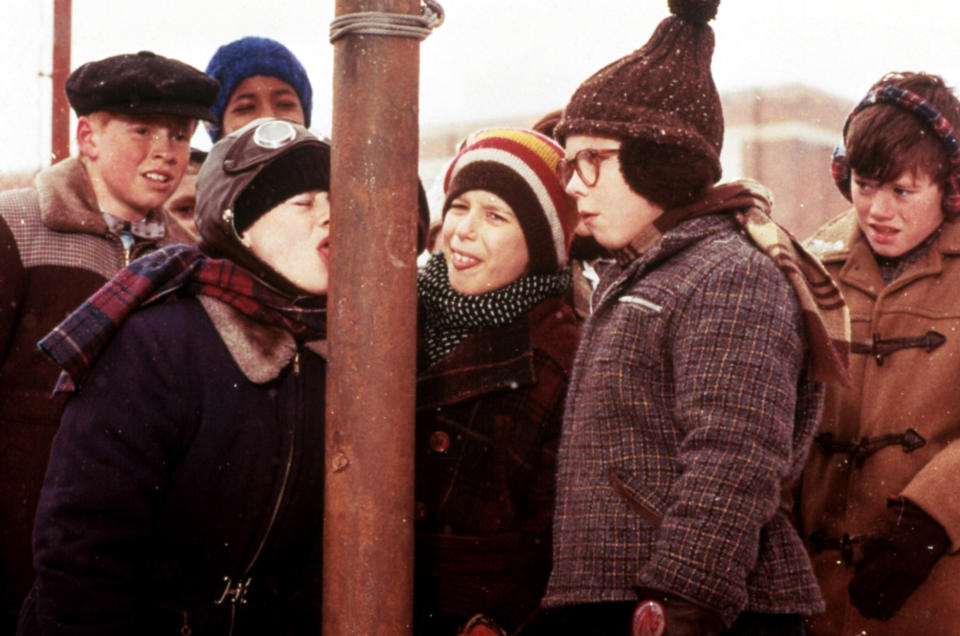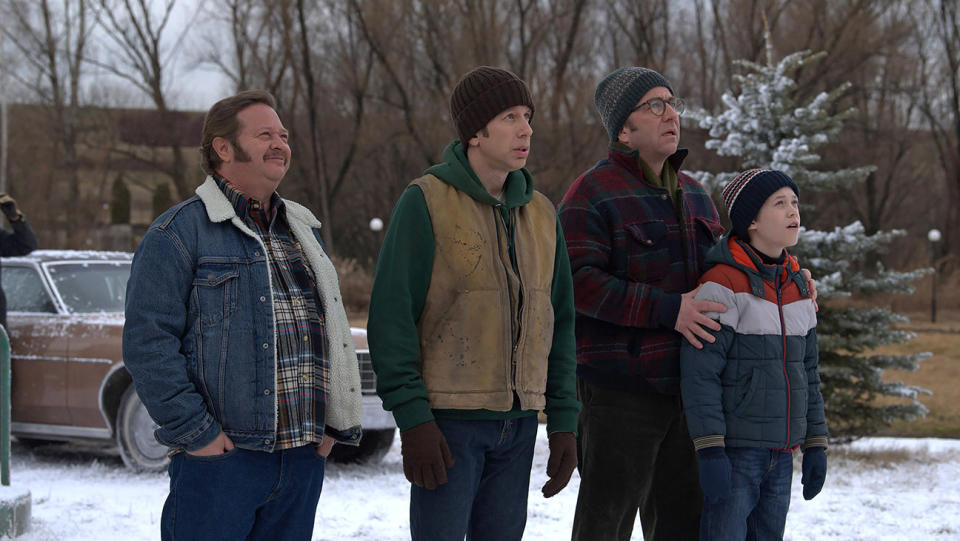‘A Christmas Story’ at 40: Peter Billingsley on Those 24-Hour Marathons and the Great ‘Die Hard’ Debate
- Oops!Something went wrong.Please try again later.
- Oops!Something went wrong.Please try again later.

The star of one of the most iconic Christmas films of all time has waded into one of the holiday season’s most divisive annual debates: Is Die Hard a Christmas movie?
Peter Billingsley says yes — and in the season finale episode of his A Cinematic Christmas Journey podcast, which releases Dec. 15, he does his best to convince Die Hard cinematographer Jan de Bont.
More from The Hollywood Reporter
The Artist Who Created the Iconic Turtle Doves in 'Home Alone' Is Now Selling Them on Amazon
The 55+ Best Gifts for Men That Aren't All Power Tools or Boring Socks
“I mean, they didn’t think Die Hard was a Christmas movie. They happened to set it then, but the filmmakers weren’t intending that,” Billingsley explains. Instead, like many classics over the decades, its meaning to fans evolved. “This movie creates its own life, is in the culture and, over time, people discover it. It’s pretty great to see how that life can move in ways that the filmmakers never intended, or even ever imagined.” (Watch an exclusive clip from the episode below.)
The podcast, which launched last year with an episode on A Christmas Story, was co-created by Vince Vaughn and is hosted by Billingsley and comedian Steve Byrne. The holiday films they’ve done deep dives on so far include Vaughn’s Fred Claus and Four Christmases, How the Grinch Stole Christmas, Home Alone and National Lampoon’s Christmas Vacation.
“People like Jan and Beverly D’Angelo from Christmas Vacation, it’s nice to have a comfortable environment to sit and have a well thought out, in-depth conversation about the movies that they love,” Billingsley says. “They know the power of these movies and what they mean to fans.”
He continues, “We do the podcast in partnership with Spotify and we’ve got a video component, which is great. When filmmakers are in studio, we’re able to show them clips and get them to remember what they were doing and decode some of the tricks they used on set.”
Ahead of the finale, Billingsley spoke with The Hollywood Reporter about A Christmas Story turning 40, what he learned about the film while making the podcast, and why he used to apologize for the 24-hour marathons.
***
So, how did the podcast get started?
It was an original idea of Vince Vaughn’s, who I have had a friendship and working collaboration with for a very long time. We were talking and realizing that both of us have done a lot of Christmas movies. I think I’ve done five now. It was his idea to take a deep dive into these Christmas classics, sit with the filmmakers and really explore how the magic is made. To really connect to all those feelings that the movies deliver over and over again, and just that timeless meaning of Christmas. It was my first foray into podcasting and I’ve really, really loved it.
How are you choosing which films to feature?
Well, definitely they have to be Christmas movies. We try to get kind of a diverse group of them. We try to do one classic. We did It’s a Wonderful Life season one, and we did Miracle on 34th Street season two. It’s nice to look back at something that’s even older that’s really retained its viewership, in the case of both those movies that were done in the ’40s, for coming up on 80 years. We did this year — I know there’s a bit of a debate on it — Die Hard, which I feel is definitely a Christmas movie.
I heard you tried to convince the cinematographer of that during the course of your chat with him.
Yes. Jan de Bont, who’s the cinematographer of Die Hard. He’s a great filmmaker, directed Speed and Twister and lots of others. I was watching some interviews preparing for the podcast with him, and he was saying he just doesn’t get it. He just doesn’t look at it as a Christmas movie, doesn’t feel it’s a Christmas movie. So, I asked him if I could attempt to change his mind. If you tune in, there’s a segment where I plead my case to Jan to see if I can convince him that it is, in fact, a Christmas movie.

Why did he agree to do a Christmas podcast?
People enjoy talking about the movies that they love, especially the movies that have gotten into the culture. I think one of the great things about the podcast format is that it’s longer form. Doing press over the years, A Christmas Story comes up a lot; Elf comes up, or other things that I’ve been a part of, and generally those are maybe a six- or seven-minute segment. They’re more bite-sized. I think people really enjoy being able to share with the audience in a slightly longer, more insightful way what the journey of making those movies was like and how they were able to create that magic. To have a chance to really walk through how the film was made, what some of the struggles were along the way, and get a chance to deep dive.
It’s funny because [Jan] knew it was a Christmas podcast. Then I brought it up, I said, “We profile Christmas movies.” He’s like, “Yeah.” And I said, “We really believe this is one.” He said, “I just don’t get it.” Then I plead my case. I’ve done my research in terms of why I feel that it’s a Christmas movie and audiences have kind of embraced it and really made it that.
It takes place on Christmas Eve. It’s surrounded by Christmas music, opens with “Christmas in Hollis” and ends with “Let It Snow.” It takes place literally at a Christmas party. There are Christmas decorations all throughout the movie — but, most importantly, it’s really about this relationship and this family that’s a little bit fractured and the trip that John McClane takes to Los Angeles is in hopes to repair that. Obviously, a robbery intervenes. But the whole movie is about him trying to save his wife, save his marriage, save his family. Instead of shopping for a tree and cooking a Turkey dinner, there’s gunfire in the middle, but it’s really about that. I think the fans have looked at it and said, “Hey, this is an R-rated Christmas movie, but still a Christmas movie.”
The first podcast episode you released was A Christmas Story, right?
Yes, we had Flick, Schwartz and Randy on from the movie. Scott Schwartz, R.D. Robb and Ian Petrella. It was fun because we hadn’t really talked as a group about the movie in a long time. So, even though I did that movie, I learned a lot from the guys from hearing their point of view and perspective about it.
You all have your own sort of pocket on the set and your own frame of reference. I had forgotten that, when we shot the original flagpole scene, the film negative got damaged and we had to reshoot the entire scene. I was reminded of that by Scott, and then you just learn different insights or perspectives. I had forgotten that Bob Clark, the director, really kept the bullies away from us. He encouraged us to build a friendship and to play together and to hang out. So, we felt like friends, but he didn’t want us playing or hanging out with the bullies, Zack [Ward] and Yano [Anaya], because he wanted that genuine fear on camera. He didn’t want that comfort. So, you learn things that you either forgot or didn’t know, even when I’m [highlighting] a movie that I had worked on as intimately as that one.

What’s it like for you to have been part of one of the most iconic Christmas movies ever? It’s the only one that I’m aware of that they play for 24 hours straight every year.
In a good way, because the movie grew over time, I think it also helped my appreciation grow over time. When it came out in ’83, it was a modest success, not a massive hit. It wasn’t overnight that it changed my life. That was the time, obviously before streaming, there was no video, really. Betamax was just starting, early VHS, and then there was no real cable. Movies didn’t have a massive life, except for maybe a little bit of TV play.
I remember I was in a video store in Phoenix, I think this was in the ’90s, and there was a cardboard cutout of me in the cowboy suit. I was like, “What?” I asked the clerk and he said, “Yeah, people keep asking for this movie.” Every Christmas it seems to get more and more popular. It was cool to be a part of something that had a second life. Then once the marathon started, it really took off and got more to mainstream status. At first when the marathon came on, I was apologizing to people. I was like, “I have nothing to do with this, sorry that they’re airing this 24 straight hours.” Now it’s on two different networks. It’s on TNT and TBS for 24 straight hours.
Why did you want to do the sequel, A Christmas Story Christmas (2022)?
That was 39 years later, maybe the longest eventual sequel for a film. I think it had been so long, in a good way, that the idea of exploring those characters as really different people, as grown-ups, was appealing. What would Ralph be like as a dad? Where would he be now? Thinking about what Scut Farkus would be like, and Flick and Schwartz. Jean Shepherd, who had written the books, had done a lot of writing of Ralph older. So, we were able to option a lot of that source material through partnering with Legendary. In looking at it, it got exciting to take advantage of that world and those characters and try to return to that same feeling of the Parker family, but now in the 1970s. The idea that it’s really the origin story of A Christmas Story gave the movie a strong sense of purpose, and once we had landed on that, I felt really motivated to want to do it. Obviously, it’s not the kind of movie that you wanted to get wrong because certainly there’s a risk in tarnishing the original and people’s love of it, but I’m very happy with where things landed.

It’s the 40th anniversary this year, right?
It is, yes. It came out in November 40 years ago, which is crazy. The Cleveland Film Commission threw an event, which was really fun. Cleveland was really a great partner for a small movie that really nobody wanted to make, and took filmmakers close to 12 years to get made. I think it was just an afterthought for the studio at the time. Bob Clark, the director, had agreed to do other work for them to get it made, threw his whole salary in. It was really a labor of love. So, it’s been very cool to see where it’s come to — somewhat similar to It’s a Wonderful Life. That movie really bombed when it came out. I know it was sort of heartbreaking for [director Frank] Capra at the time. And because somebody forgot to re-up the copyright, the movie fell into the public domain and television stations started to broadcast it and suddenly it found this incredible life and found its audience.
These movies really do have a life of their own. It’s been pretty incredible to see how a lot of the movies that are classics were disappointing on their release at first, or had concerns with marketing, or issues that resulted in the films not performing as well as people had hoped. Over time, when people find them, the movie doesn’t change and it’s the power of the message of the movie that they created that really stands the test of time. That’s been a very common theme throughout.
I mean, they didn’t think Die Hard was a Christmas movie. They happened to set it then, but the filmmakers weren’t intending that. This movie creates its own life, is in the culture and over time people discover it. It’s pretty great to see how that life can move in ways that the filmmakers never intended, or even ever imagined.
When you think back about making A Christmas Story, at this point 40 years later, what are the memories that jump out to you?
In a similar way, it was a very different movie. I had done some larger movies that really were not very successful. As a kid actor, you felt all the hype before the movie was done. “This is going to be a hit. It’s going to make you a star.” You heard all those comments. Getting to the set of A Christmas Story was an extremely different environment. I think it was because of the struggles that the filmmakers had gone through for so long to try to get the movie made, and their budget was reduced. They were so prepared. I always call it a “take your lunch pail to work” movie set. It was just do the work, try to elevate the work, make it great. There was no discussion of what the movie was going to do. All the focus was on trying to make the movie and working really hard.
I don’t know that I fully understood it then, but as I look back at it, the level of preparation, the level of detail that went into the making of the movie, that’s where all the energy went. Control what you can control, which is that time on set, the script and the production design and all the details. As I got older and can look at it, and had to study it a lot for the sequel, you can see the detail and all the effort that went into it. So, it’s not surprising that it’s the one that’s really broken out of the pack.
As for the podcast, what is on your wish list in terms of films you’d like to do?
We’d like to go into some other genres, as well. We did a series on adventure movies. We did Back to the Future, Raiders of the Lost Ark and some others. As it grows, I think there’s a lot of stories to be told behind these movies, and it’s fun to look at how you can pair six movies each cycle into a group. There’s just so many actors and filmmakers that enjoy looking back and reflecting on these movies that have become classic. There’s some great stuff out there on some of these movies, but so much of it is shortform. To be able to do it in a longer-form setting is great, and I think audiences appreciate having someone who’s not only a fan but a filmmaker to help break it down. I can kind of translate some things, or give examples of where I faced some of those similar hurdles, or try to give more context. So, I’m just excited to keep diving into more and more films and more and more genres.
A Cinematic Christmas Journey, which is produced by Vaughn’s Audiorama, is available on Spotify, as well as other major platforms including Apple, YouTube and Audible.
Best of The Hollywood Reporter
Eight Actors Who Have Played Willy Wonka in Films and on Broadway
Martin Scorsese’s 10 Best Movies Ranked, Including 'Killers of the Flower Moon'

